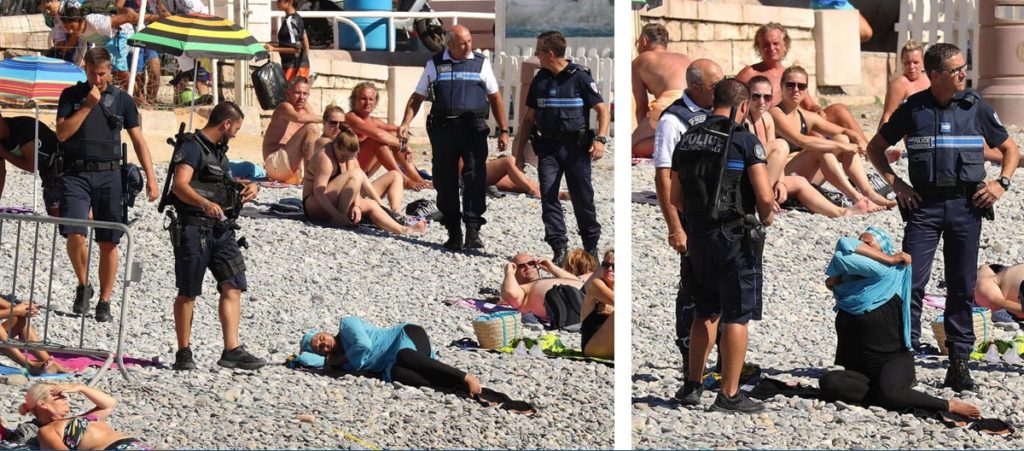On a bright sunny morning Siam, a mother of two was enjoying her day on the beach, lying down and relaxing on the warm sand with her two children not knowing that her leisurely moments would not last long as she was abruptly awoken by four police officers. Her crime, modesty.
The 34 year old french national was fined 9 euros for wearing a burkini on the Cannes beach. Such extreme action was taken against the mother of two in light of the new burkini ban. The ban which has been implemented in almost 15 French cities prohibits anyone from wearing religious garb to the beach, with special notice taken against the burkini.
The burkini is a full body swim suit much like any other swimsuit except for an attached headpiece used for covering the hair. The inventor of the burkini Aheda Zanneti originally designed it for Muslim women so that they could enjoy their trips to the beach, however, the two-piece, fast drying suit gained popularity as it gained praise from people diagnosed with skin cancer and for those who wanted to protect themselves from the sun, for which the burqini was a savior.
The ban came as a reaction to the recent terror attacks in France, however, it is hard to perceive how the authorities linked mass murder with women wearing bathing suits. What the authorities view as promoting terrorism, Muslim women view as a way to enjoy life and integrate within society without conflicting with their religion.
The Burkini which represents the values of modesty, respect, love for religion, intellectual capability and liberalism are not different from the French national values. What’s more unusual is that, contradictory to what is usually claimed, a majority of Muslim women are of the opinion that such clothing provides liberation and promotes liberalism. They are liberated from the objectifying eyes of society and are no longer compelled to yield to society’s unattainable standards of beauty, that beauty can only be reached by showing more skin.
The most hypocritical part is yet to come; The moral standard that French authorities claim to uphold and protect is now being breached by none other than themselves. They condemn the hijab because they think that women are being forced to wear it while on the other hand they themselves force women to take it off and in cases rip it off their heads. If you look at it from a different perspective you can see that it is no different than some Muslim countries forcing women to cover up.
The reason being given in this case is that when people see the hijab they associate it with terrorism making way for “social unrest”. Let me clear the air. The Hijab is not associated with terrorism, it is associated with Islam, which rejects extremism. The only time it is associated with terrorism is when four armed police officers surround a woman with two children terrorizing her to conform to your extreme ways while one officer aims a can of pepper spray at her face.
This is extremism; this is the carefully laid out plan of the terrorists. To divide societies, to create gaps, to incite hatred, to turn the people against each other. And so far they are winning. And all we have managed to accomplish is an increase of the Burkini sales by 200%.


Although the burkini MAY represent to some Muslim sects " the values of modesty, respect, love for religion, intellectual capability and liberalism" and that is an admirable intention indeed, let us be clear that the burkini does not fit the requirements of acceptable Islamic dress for women in public as understood by the Ahmadiyya sect of Islam. For those who choose to follow the extensively detailed and oft-repeated guidelines for pardah laid down by the Ahmadiyya sect of Islam, the burqini is not an acceptable substitute for the burqa at the beach. There is absolutely no compulsion for any other sects of Muslim to follow the Ahmadiyya beliefs but since the latter have explained at length their reasoning behind their interpretation of the appropriate Islamic wear for women in public, and backed their interpretation of the Quranic verses by detailed reference to authentic ahadith (Bukhari, “Kitab al-Nikah”, inter alia), sunnah and Arabic lexicography, the burden of proof to the contrary lies with the former.
For instance, when the Holy Quran says:
“O Prophet! Tell thy wives and thy daughters, and the women of the believers, that they should let down over them their loose garments. That is more likely that they may thus be recognized and not molested. And Allah is Most Forgiving, Merciful.” (ch. 33, v. 60)
In this, the word used for outer cloaks, “Jalabib”, is described by the lexicographer of Arabic, E.W. Lane, as “(a) a woman’s outer wrapping garment; (b) a garment that envelops the whole body; (c) a garment worn by a woman that entirely envelops the body so that not even a hand is left uncovered.”